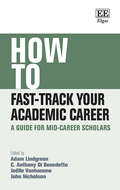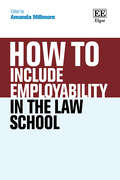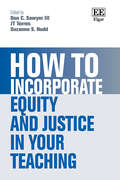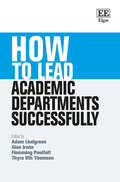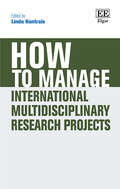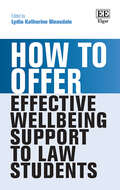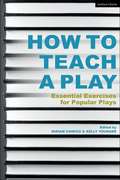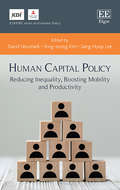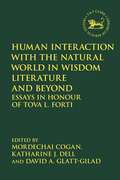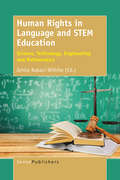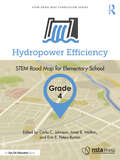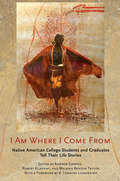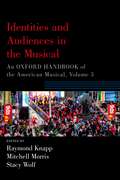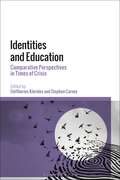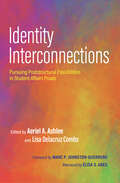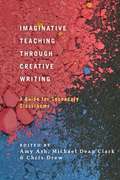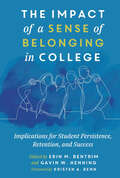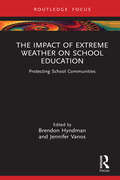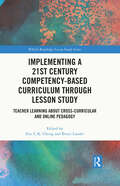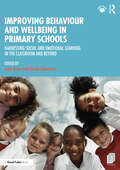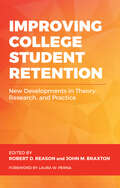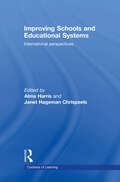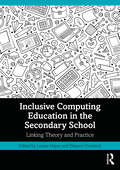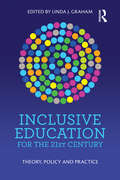- Table View
- List View
How to Fast-Track Your Academic Career: A Guide for Mid-Career Scholars (How To Guides)
This insightful book considers the challenges faced by researchers pursuing an academic career. From applying for grants to supervising PhD students, it utilises practical research and real experiences to illustrate how marketing scholars can strike a healthy working balance between teaching and research to find success in academia. Experienced scholars outline the key stages towards building an effective and varied academic portfolio, incorporating pragmatic insights into generating ideas, building research groups, and drafting funding applications. The book describes the processes involved in both collaborating with peers and engaging with research students, paying close attention to the ways in which scholars translate research into teaching. Offering crucial advice based on practical knowledge, the book guides early- to mid-career scholars to publication success and highlights the most effective ways to maintain relevance, impact, and societal value throughout one’s career. Providing a holistic view of research culture, this cutting-edge book is critical reading for early- to mid-career scholars. The book will also be useful for recent graduates planning their careers in academia.
How To Include Employability in the Law School (How To Guides)
This accessible How To Guide provides practical guidance on how to successfully include employability into the law school. Innovative ideas are shared on how to establish effective independent employability initiatives and embed employability within the law curriculum itself.Bringing together a team of highly experienced legal educators, this book focuses on providing hands-on tips and advice for both new and seasoned teachers. Contributors present a diverse range of case studies, from small employability initiatives within law modules to authentic methods of teaching and assessment that mimic the workplace. Looking beyond employability solely in the legal sector, they explore how to support the development of students’ transferable skills and attributes. The book also highlights important developments in legal education such as including employability considerations in academic tutoring and targeting support towards underrepresented groups of students.How to Include Employability in the Law School will prove an invaluable guide for legal educators seeking to enhance their teaching. It will also be an important resource for educational developers, providing practical examples of successful employability initiatives tailored to their educational context.
How to Incorporate Equity and Justice in Your Teaching (How To Guides)
How to Incorporate Equity and Justice in Your Teaching advocates for radical inclusivity in the contemporary social science classroom. Including a range of adaptable course materials, this forward-thinking book will enable instructors working at a range of levels to integrate equity and social justice into their practice.Editors Don C. Sawyer III, JT Torres and Suzanne S. Hudd encourage instructors to broaden their understanding of the institutional and societal contexts in which their classes are taught, as well as the demographic makeup of their student bodies. The book further suggests flexible frameworks and strategies for effectively engaging in socially just pedagogical activities, where multiple perspectives are empowered and classroom community is forged. It models a reflective, lifelong approach towards equity; one that engenders a temperament that can readily be applied outside of the classroom to facilitate wider social justice initiatives in the workplace and in society at large.A crucial read for academics, scholars and researchers in higher education and teaching methods in the social sciences, this book will also be a blueprint for increasing inclusivity in the classroom, benefitting instructors beginning their diversity equity and inclusivity training, as well as institutional administrators who oversee faculty programming.
How to Lead Academic Departments Successfully (How To Guides)
It is an old cliché that leading and managing academics is like herding cats. This book challenges this myth and presents a way to deal with the many challenges of academic leadership, from managing departments, research groups and teams to managing tensions between research and teaching. The book is a practical and stimulating guide to different pathways to successful academic leadership, both in personal and organizational terms.
How to Manage International Multidisciplinary Research Projects
This insightful How to guide is expertly crafted to assist mid-career academic and non-academic researchers in preparing for new and innovative ways of working in international multidisciplinary environments.
How to Offer Effective Wellbeing Support to Law Students (How To Guides)
This How to Guide will provide readers with information and insights which will better equip them to support law students in a higher education setting. Featuring contributions from an array of eminent academics and student support professionals, this book includes personal reflections, example scenarios and practical tips for those seeking to improve support for student wellbeing.How to Offer Effective Wellbeing Support to Law Students discusses issues that impact wellbeing from a variety of perspectives including distance learning, the influence of sex and gender on the provision of pastoral support, and the challenges of providing wellbeing support at the same time as maintaining personal wellbeing. Written in an informative yet accessible style, chapters provide strategies to work with law students in a supportive capacity while integrating wellbeing as a core component of day-to-day teaching. Ultimately this How to Guide concludes that although wellbeing support varies between universities, there are universal traits and frameworks throughout that can encourage more effective and tailored welfare assistance.This will be an excellent resource for early career researchers and more established academics in the field of law who undertake teaching and supervisory responsibilities. It will also be of interest to student support professionals as they seek to improve their techniques when working with law students.>
How to Teach a Play: Essential Exercises for Popular Plays
Most students encounter drama as they do poetry and fiction – as literature to be read – but never experience the performative nature of theater. How to Teach a Play provides new strategies for teaching dramatic literature and offers practical, play-specific exercises that demonstrate how performance illuminates close reading of the text. This practical guide provides a new generation of teachers and theatre professionals the tools to develop their students' performative imagination. Featuring more than 80 exercises, How to Teach a Play provides teaching strategies for the most commonly taught plays, ranging from classical through contemporary drama. Developed by contributors from a range of disciplines, these exercises reveal the variety of practitioners that make up the theatrical arts; they are written by playwrights, theater directors, and artistic directors, as well as by dramaturgs and drama scholars. In bringing together so many different perspectives, this book highlights the distinctive qualities that makes theater such a dynamic genre. This collection offers an array of proven approaches for anyone teaching drama: literature and theater professors; high school teachers; dramaturgs and directors. Written in an accessible and jargon-free style, both instructors and directors can immediately apply the activity to the classroom or rehearsal. Whether you specialize in drama or only teach a play every now and again, these exercises will inspire you to modify, transform, and reinvent your own role in the dramatic arts.Online resources to accompany this book are available at:https://www.bloomsbury.com/how-to-teach-a-play-9781350017528/.
Human Capital Policy: Reducing Inequality, Boosting Mobility and Productivity (KDI/EWC series on Economic Policy)
This timely book evaluates international human capital policies, offering a comparative perspective on global efforts to generate new ideas and novel ways of thinking about human capital. Examining educational reforms, quality of education and links between education and socio-economic environments, chapters contrast Western experiences and perspectives with those of industrializing economies in Asia, focusing particularly on Korea and the USA. Contributors analyse trends in Korean education, including state, charter and private education, higher education and student loans and debt, and provide policy prescriptions for the improvement of higher education financing in the USA. Offering theoretical insights into the relationship between socio-economic and educational benefits for children and young people, and human capital formation, further chapters consider recent empirical evidence on disadvantaged people in the USA, before broadening the scope of analysis to consider the effects of human capital on industrial structure and productivity among OECD countries. Providing a unique and incisive understanding of human capital formation in the context of education, this book lays out guidance to scholars and researchers of human capital, particularly those concentrating on policies in Korea and the USA. It will also be useful to policymakers involved in economic and education policy.
Human Interaction with the Natural World in Wisdom Literature and Beyond: Essays in Honour of Tova L. Forti (The Library of Hebrew Bible/Old Testament Studies)
Created in honor of the work of Professor Tova Forti, this collection considers the natural world in key wisdom books - Proverbs, Job and Qoheleth/Ecclesiastes, Ben Sira and Song of Songs/Solomon - and also examines particular animal and plant imagery in other texts in the Hebrew Bible. It crucially involves ancient Near Eastern parallels and like texts from the classical world, but also draws on rabbinic tradition and broader interpretative works, as well as different textual traditions such as the LXX and Qumran scrolls.Whilst the natural world, notably plants and animals, is a key uniting element, the human aspect is also crucial. To explore this, contributors also treat the wider concerns within wisdom literature on human beings in relation to their social context, and in comparison with neighbouring nations. They emphasize that the human, animal and plant worlds act together in synthesis, all enhanced and imbued by the world-view of wisdom literature.
Human Rights in Language and STEM Education: Science, Technology, Engineering and Mathematics
This volume explores the challenges of teaching and learning Science, Technology, Engineering and Mathematics (STEM) subjects in local languages and local contexts in a range of countries around the world. Many countries around the world, including African countries, have been largely excluded from the transformation that is going on in STEM pedagogy in the USA, where the emphasis is on the importance of language choice and the development of English Language Learner (ELL). STEM subjects in many parts of the world have been taught in a global language, mainly English, rather than using a local language and local curriculum. This creates pedagogical challenges to the teaching of STEM. The contributions to this book review evidence and arguments for the teaching of STEM subjects in local languages and several chapters make this case that this should be considered a human right, both in national educational programs and in development aid. Working across disciplines and domains has the potential to lead to new understanding and the removal of barriers to progress with the ultimate goal of creating solutions to persistent problems in education. Cross-disciplinary work in science, language and literacy has shown much promise and demonstrated the importance of developing language along with disciplinary knowledge. This volume provides a deep dive into this topic, with articles by several scholars in the field of language in STEM.” – Jaqueline Barber, Director of the Learning Design Group at the Lawrence Hall of Science, University of California-Berkeley, USA“In an increasingly technological world, STEM Education has become a priority on national agendas and in educational institutions. Meaningful access to STEM education can enable or hinder young people from gaining entry into the world of work. It is against this backdrop that the edited collection, Human Rights and Language in STEM Education, needs to be welcomed. The various chapters tackle the big questions of access and many others. This edited collection is required reading for all those working in STEM and for policy makers who tend to see language and STEM as binaries, rather than as interdependent.” – Zubeida Desai, Professor and Dean of Education, University of the Western Cape, South AfricaThis volume by researchers from 10 countries provides a thought-and-action provoking multidimensional analysis of issues on the dignity of the use of STEM subjects in local education in the perspective of human rights. This book is especially recommended to researchers and education policy makers in such areas as STEM Educational Theory and Praxis, Human Rights, Future/sustainable Development, Science and Technology Literacy. May it inspire similar volumes in today’s politically ebullient world.” – Francisco Gomes de Matos, Professor Emeritus of Linguistics, human linguistic rights scholar, Federal University of Pernambuco, Recife, Brazil.
Hydropower Efficiency, Grade 4: STEM Road Map for Elementary School (STEM Road Map Curriculum Series)
What if you could challenge your fourth graders to create a minimally invasive, highly efficient dam? With this volume in the STEM Road Map Curriculum Series, you can! Hydropower Efficiency outlines a journey that will steer your students toward authentic problem solving while grounding them in integrated STEM disciplines. Like the other volumes in the series, this book is designed to meet the growing need to infuse real-world learning into K–12 classrooms.This interdisciplinary, four-lesson module uses project- and problem-based learning to help students create a highly efficient dam that has a minimal impact on the environment. Students will explore the use of natural resources to provide energy needs, specifically hydropower, while exploring the workings of watermills, wind turbines, and generators to help build an understanding of the effects of dams. In creating their dam, they will learn about the various types of alternative hydropower sources, including wave and tidal power, and track the progress of electrification in the U.S. on a timeline; alongside researching the positive and negative consequences of hydropower.To support this goal, students will do the following: Use the engineering design process (EDP) to create a design for a dam, wind turbine, and water wheel Compare and contrast renewable power sources Evaluate power sources for efficiency Identify positive and negative consequences of human modifications of the environment Identify and describe how several sources of renewable energy are used across the U.S. Use mapping skills to determine where natural resources are being accessed for energy usage Effectively utilize shapes, materials, and measurements to create a model of a hydropower system The STEM Road Map Curriculum Series is anchored in the Next Generation Science Standards, the Common Core State Standards, and the Framework for 21st Century Learning. In-depth and flexible, Hydropower Efficiency can be used as a whole unit or in part to meet the needs of districts, schools, and teachers who are charting a course toward an integrated STEM approach.
I Am Where I Come From: Native American College Students and Graduates Tell Their Life Stories
"The organizing principle for this anthology is the common Native American heritage of its authors; and yet that thread proves to be the most tenuous of all, as the experience of indigeneity differs radically for each of them. While many experience a centripetal pull toward a cohesive Indian experience, the indications throughout these essays lean toward a richer, more illustrative panorama of difference. What tends to bind them together are not cultural practices or spiritual attitudes per se, but rather circumstances that have no exclusive province in Indian country: that is, first and foremost, poverty, and its attendant symptoms of violence, substance abuse, and both physical and mental illness.... Education plays a critical role in such lives: many of the authors recall adoring school as young people, as it constituted a place of escape and a rare opportunity to thrive.... While many of the writers do return to their tribal communities after graduation, ideas about 'home' become more malleable and complicated."—from the IntroductionI Am Where I Come From presents the autobiographies of thirteen Native American undergraduates and graduates of Dartmouth College, ten of them current and recent students. Twenty years ago, Cornell University Press published First Person, First Peoples: Native American College Graduates Tell Their Life Stories, also about the experiences of Native American students at Dartmouth College. I Am Where I Come From addresses similar themes and experiences, but it is very much a new book for a new generation of college students.Three of the essays from the earlier book are gathered into a section titled "Continuing Education," each followed by a shorter reflection from the author on his or her experience since writing the original essay. All three have changed jobs multiple times, returned to school for advanced degrees, started and increased their families, and, along the way, continuously revised and refined what it means to be Indian.The autobiographies contained in I Am Where I Come From explore issues of native identity, adjustment to the college environment, cultural and familial influences, and academic and career aspirations. The memoirs are notable for their eloquence and bravery.
Identities and Audiences in the Musical: An Oxford Handbook of the American Musical, Volume 3 (Oxford Handbooks)
Issues of identity have always been central to the American musical in all its guises. Who appears in musicals, who or what they are meant to represent, and how, over time, those representations have been understood and interpreted, provide the very basis for our engagement with the genre. In this third volume of the reissued Oxford Handbook of the American Musical, chapters focus on race, ethnicity, gender, and sexuality, regional vs. national identity, and the cultural and class significance of the musical itself. As important as the question of who appears in musicals are the questions of who watches and listens to them, and of how specific cultures of reception attend differently to the musical. Chapters thus address cultural codes inherent to the genre, in particular those found in traditional school theater programs.
Identities and Education: Comparative Perspectives in Times of Crisis
Education is central to the project of individual and collective identity formation, national development and international relations, and is crucial in moments of crisis. What should be the agenda of study and action for education in such times? Identities and Education engages with this crucial question, seeking to examine and problematise our contemporary moment. Through the heuristic of the concept of identity, it specifically aims at creating a space for understanding our current challenges and considering the potential of education to address them. Contributors in this volume explore identity, crisis and education, not only in interdisciplinary, inter-sectional, relational and eclectic ways, but also through comparative lens. The book includes contributions from leading scholars from Austria, Cyprus, Germany, Greece, Portugal, the UK, and the USA and covers issues and themes including fear, hope, refugee education and global citizenship education.
Identities and Education: Comparative Perspectives in Times of Crisis
Education is central to the project of individual and collective identity formation, national development and international relations, and is crucial in moments of crisis. What should be the agenda of study and action for education in such times? Identities and Education engages with this crucial question, seeking to examine and problematise our contemporary moment. Through the heuristic of the concept of identity, it specifically aims at creating a space for understanding our current challenges and considering the potential of education to address them. Contributors in this volume explore identity, crisis and education, not only in interdisciplinary, inter-sectional, relational and eclectic ways, but also through comparative lens. The book includes contributions from leading scholars from Austria, Cyprus, Germany, Greece, Portugal, the UK, and the USA and covers issues and themes including fear, hope, refugee education and global citizenship education.
Identity Interconnections: Pursuing Poststructural Possibilities in Student Affairs Praxis
Co-published with This book advocates an approach the authors call Identity Interconnections as a way of moving considerations of identity differences and commonalities from theory to socially just action in student affairs practice.Through pursuing complex commonalities expansive enough to hold both similarities and differences, student affairs educators can ethically consider identity interconnections in such a way that does not diminish difference, but instead recognizes points of difference as opportunities for social justice action. By pursuing radical interconnectivity, student affairs educators can advance an interdependent understanding of inherited systems of power; recognizing the ways in which all systems (and thus all oppression, and all liberation) are interconnected. This interconnected insight can enable student affairs educators to extend beyond binary and oppositional thinking, and in turn, give rise to the formation of new coalitions. Finally, by listening with raw openness (allowing themselves, and encouraging their students, to be changed by others’ experiences), student affairs educators can facilitate identity development and social justice action as interrelated endeavors.The editors have heard comments like, “This is all great in theory, but how can student affairs practitioners actually apply this?” This book answers that question by providing a theoretical framework and multiple practical examples for employing identity interconnections as expansive approaches to identity development and social justice action in student affairs.
Imaginative Teaching through Creative Writing: A Guide for Secondary Classrooms
Growing out of recent pedagogical developments in creative writing studies and perceived barriers to teaching the subject in secondary education schools, this book creates conversations between secondary and post-secondary teachers aimed at introducing and improving creative writing instruction in teaching curricula for young people. Challenging assumptions and lore regarding the teaching of creative writing, this book examines new and engaging techniques for infusing creative writing into all types of language arts instruction, offering inclusive and pedagogically sound alternatives that consider the needs of a diverse range of students. With careful attention given to creative writing within current standards-based educational systems, Imaginative Teaching Through Creative Writing confronts and offers solutions to the perceived difficulty of teaching the subject in such environments. Divided into two sections, section one sees post-secondary instructors address pedagogical techniques and concerns such as workshop, revision, and assessment before section two explores hands-on activities and practical approaches to instruction. Focusing on an invaluable and underrepresented area of creative writing studies, this book begins a much-needed conversation about the future of creative writing instruction at all levels and the benefits of collaboration across the secondary/post-secondary divide.
The Impact of a Sense of Belonging in College: Implications for Student Persistence, Retention, and Success
Sense of belonging refers to the extent a student feels included, accepted, valued, and supported on their campus. The developmental process of belonging is interwoven with the social identity development of diverse college students. Moreover, belonging is influenced by the campus environment, relationships, and involvement opportunities as well as a need to master the student role and achieve academic success. Although the construct of sense of belonging is complex and multilayered, a consistent theme across the chapters in this book is that the relationship between sense of belonging and intersectionality of identity cannot be ignored, and must be integrated into any approach to fostering belonging.Over the last 10 years, colleges and universities have started grappling with the notion that their approaches to maintaining and increasing student retention, persistence, and graduation rates were no longer working. As focus shifted to uncovering barriers to student success while concurrently recognizing student success as more than solely academic factors, the term “student sense of belonging” gained traction in both academic and co-curricular settings. The editors noticed the lack of a consistent definition, or an overarching theoretical approach, as well as a struggle to connect disparate research. A compendium of research, applications, and approaches to sense of belonging did not exist, so they brought this book into being to serve as a single point of reference in an emerging and promising field of study.
The Impact of Extreme Weather on School Education: Protecting School Communities
This book introduces an emerging area of research exploring the influence of extreme weather events on school systems. Chapters explore a range of extreme weather events such as snowstorms, bushfires, extreme winds, heavy rainfall and prolonged heat waves, and their potentially widespread impacts. It also covers key challenges faced by schools, including how to protect students, levels of teacher preparation to counter extreme weather conditions and how students' learning is impacted by extreme weather patterns. Drawing on a broad range of research in this field, this book will appeal to environmental and educational researchers, as well as those currently studying or practising in education.
Implementing a 21st Century Competency-Based Curriculum Through Lesson Study: Teacher Learning About Cross-Curricular and Online Pedagogy (WALS-Routledge Lesson Study Series)
Drawing from a comprehensive collection of university-funded teaching development projects, this edited volume explores the theories and practices behind developing pedagogies through Lesson Study for a 21st-century curriculum. It encompasses various aspects such as lesson observation, assessment literacy, online teaching pedagogy, values education, STEM education, language education, and mathematics education. The chapters investigate the application of Lesson Study in diverse contexts, highlighting its use in ICT-based teaching and learning environments, the development and refinement of e-pedagogies, as well as the integration of AI in education. Through these cases, the content demonstrates how Lesson Study empowers teachers to craft pedagogies that enhance student learning, while emphasizing its pivotal role as an innovative approach to address the evolving landscape of education in this digital era.Implementing a 21st Century Competency-Based Curriculum Through Lesson Study is the first to address the academic discussion of using Lesson Study to develop pedagogies for effective curriculum implementation to tackle the impact of Industry 4.0 on school education. It offers valuable insights, reflections, and practical guidance to policy makers, school leaders, teacher educators, and teachers who are dedicated to enhancing student learning and nurturing the essential skills required for success in the 21st century.
Improving Behaviour and Wellbeing in Primary Schools: Harnessing Social and Emotional Learning in the Classroom and Beyond
This accessible resource provides a vivid and practical guide to social and emotional learning and will help primary schools tackle and improve behaviour and wellbeing. With content written by teachers and used successfully in real classrooms, chapters include powerful stories from teachers about their work and the impact it has had. Developed within a theoretical framework of evidence-based strategies, the resources included are fully illustrated with photographs from classrooms and draw upon a useful bank of downloadable resources and proformas. Taking the reader through a journey of how a group of schools worked together to develop practical and effective approaches, this essential resource features: Tried and tested strategies for improving behaviour and wellbeing Ready-to-use classroom resources – lesson slides; top picture-books for teaching about emotions; 20 simple exercises to help children stay calm; playground conflict resources and a progression in learning emotion vocabulary from Reception to Year 6 Powerful stories from individual teachers about their work and its impact An in-depth understanding of research evidence on what works in tackling social, emotional and mental health needs from best-selling author and expert Jean Gross Children’s social, emotional and mental health needs have never been of more concern to teachers than they are now — this book genuinely brings theory to life and is essential reading for today’s primary teachers, SENCOs, support staff and safeguarding leads.
Improving College Student Retention: New Developments in Theory, Research, and Practice
Higher education institutions have already begun to see decreasing enrollment numbers, even as higher education enrollment is predicted to drop precipitously starting in 2025. Much of the decrease in enrollment will be driven by demographic trends about which higher education institutions can do little, making the retention of students who do enroll that much more important. Overall retention rates have stagnated and differential retention rates by race and ethnicity have persisted. If higher education institutions, researchers, and policy makers are to improve retention rates, a critical examination of the current state and future directions of retention research is essential.This edited volume begins that examination by addressing several questions: What are the needed directions in theory and research on college student persistence and how do we translate new theory and research into effective practices? Are we asking the right questions, looking in the right places, or trying to apply out-of-date theories to new populations? In short, how can the research community help institutions improve retention in this challenging time?
Improving Schools and Educational Systems: International Perspectives
School improvement has become a dominant feature of educational reform in many countries. The pressure upon schools to improve performance has resulted in a wide-range of improvement programmes and initiatives which can provide both inspiration and advice to everyone involved in school improvement. This book draws together the most effective school improvement projects from around the world in one comprehensive text, including detailed comparative analysis of a wide variety of initiatives. Drawing on examples from the UK, the USA, Canada, South Africa and Australia this book gives both an international snapshot and a coherent synthesis of initiatives that have given achievable results.
Inclusive Computing Education in the Secondary School: Linking Theory and Practice
Underpinned by pedagogical practices and theories of what works in teaching computing, this book gives existing and new teachers ideas to enable them to plan an inclusive curriculum for the secondary school computing classroom. Computing is one of the fastest-developing subjects in the curriculum, and computing teachers will always be updating their subject knowledge and pedagogical approaches. Each chapter explores a specific aspect of inclusion and potential barriers faced by students and is designed to challenge teachers to think about their own practice and curriculum design. Themes include the influence of classroom environments, bias in the use of data, collaborative learning, building cultural capital, and racism within AI applications. The book is also laced with practical ideas to develop teaching shared by a wealth of experienced practitioners, researchers and industry professionals. Written with consideration for the National Curriculum for Computing, this valuable text will give trainee teachers, recently qualified teachers, and experienced teachers the confidence and knowledge they need to successfully deliver an inclusive computing curriculum in the classroom.
Inclusive Education for the 21st Century: Theory, policy and practice
Placing a student on the autism spectrum in a busy classroom with a pair of noise-cancelling headphones and an aide to deal with the inevitable meltdowns is often done in the name of 'inclusion', but this is integration and not inclusive. How can teachers and schools create genuinely inclusive classrooms that meet the needs of every student?Research evidence indicates the strategies that make schools inclusive for students with disability benefit all students. Yet many schools are still operating under twentieth-century models that disadvantage students, especially those with disability. Inclusive Education for the 21st Century provides a rigorous overview of the foundational principles of inclusive education, and the barriers to access and participation. It explores evidence-based strategies to support diverse learners, including specific changes in curriculum, pedagogy and assessment practices, and the use of data. It addresses the needs of children with physical, sensory and intellectual disabilities, as well as those with complex learning profiles, including mental health issues.With chapters from leading experts from Australia and the UK, Inclusive Education for the 21st Century addresses common issues in both primary and secondary schools. Underpinned throughout by research evidence, it is designed to assist educators to develop the deep knowledge required to make inclusive education a reality in all schools.
